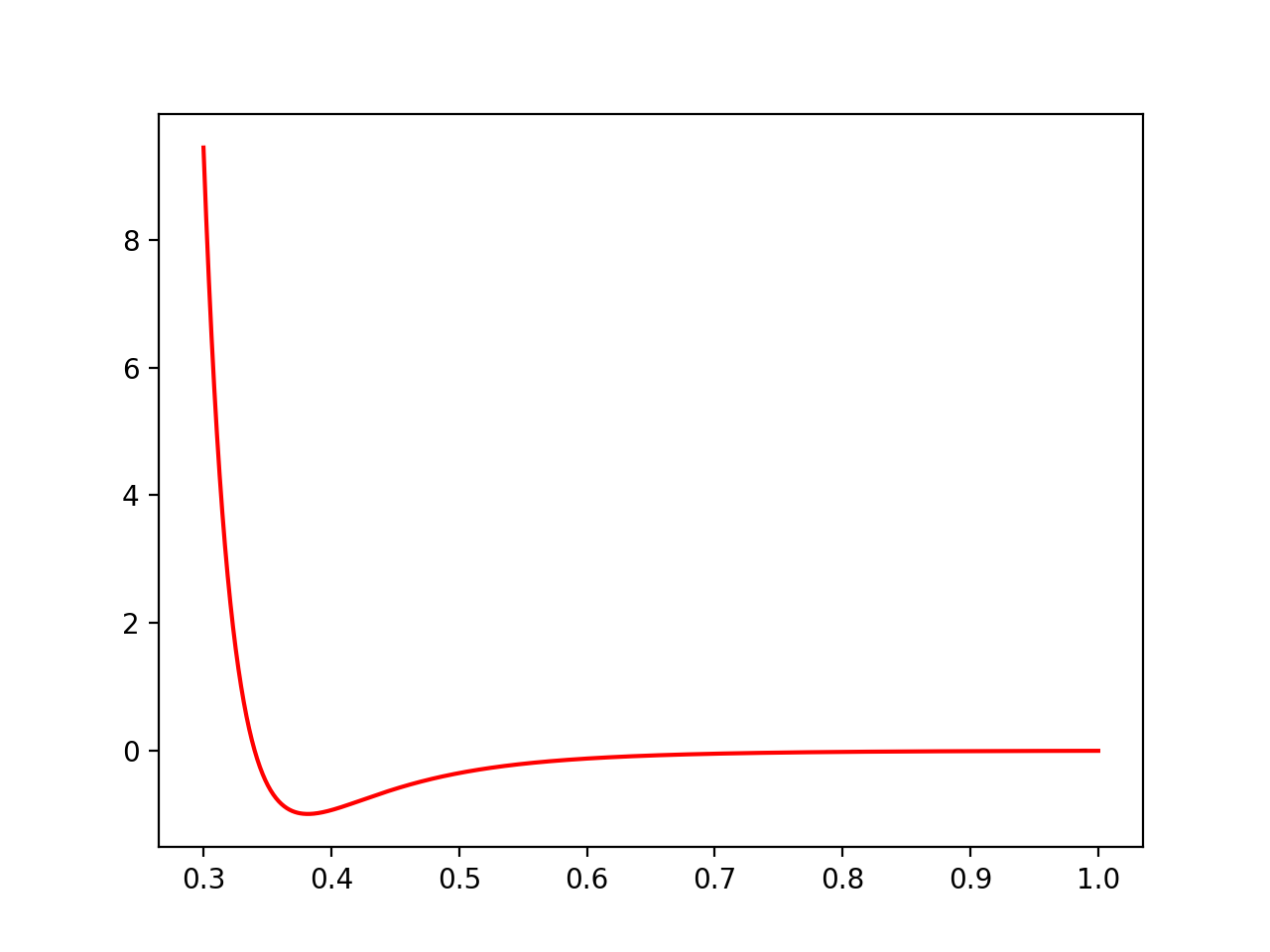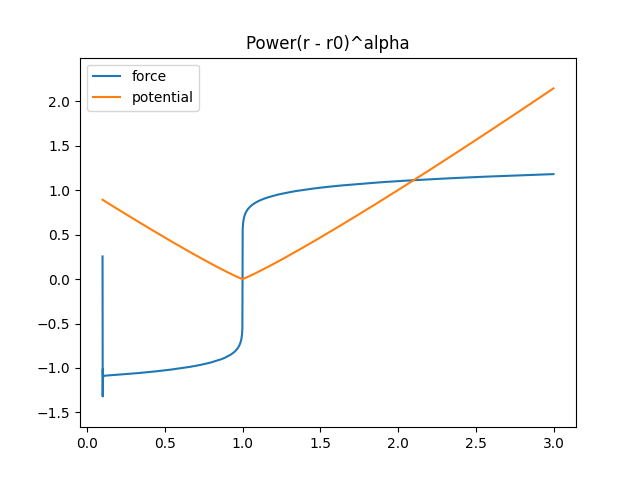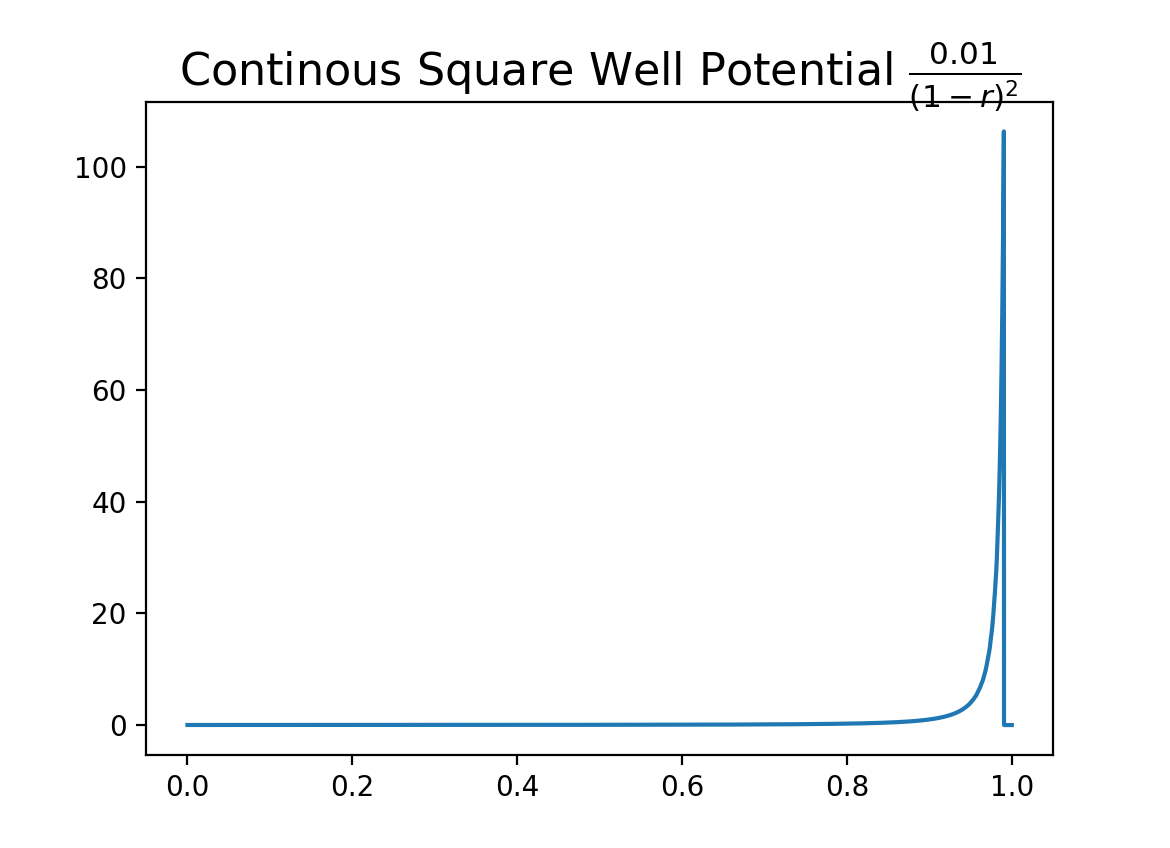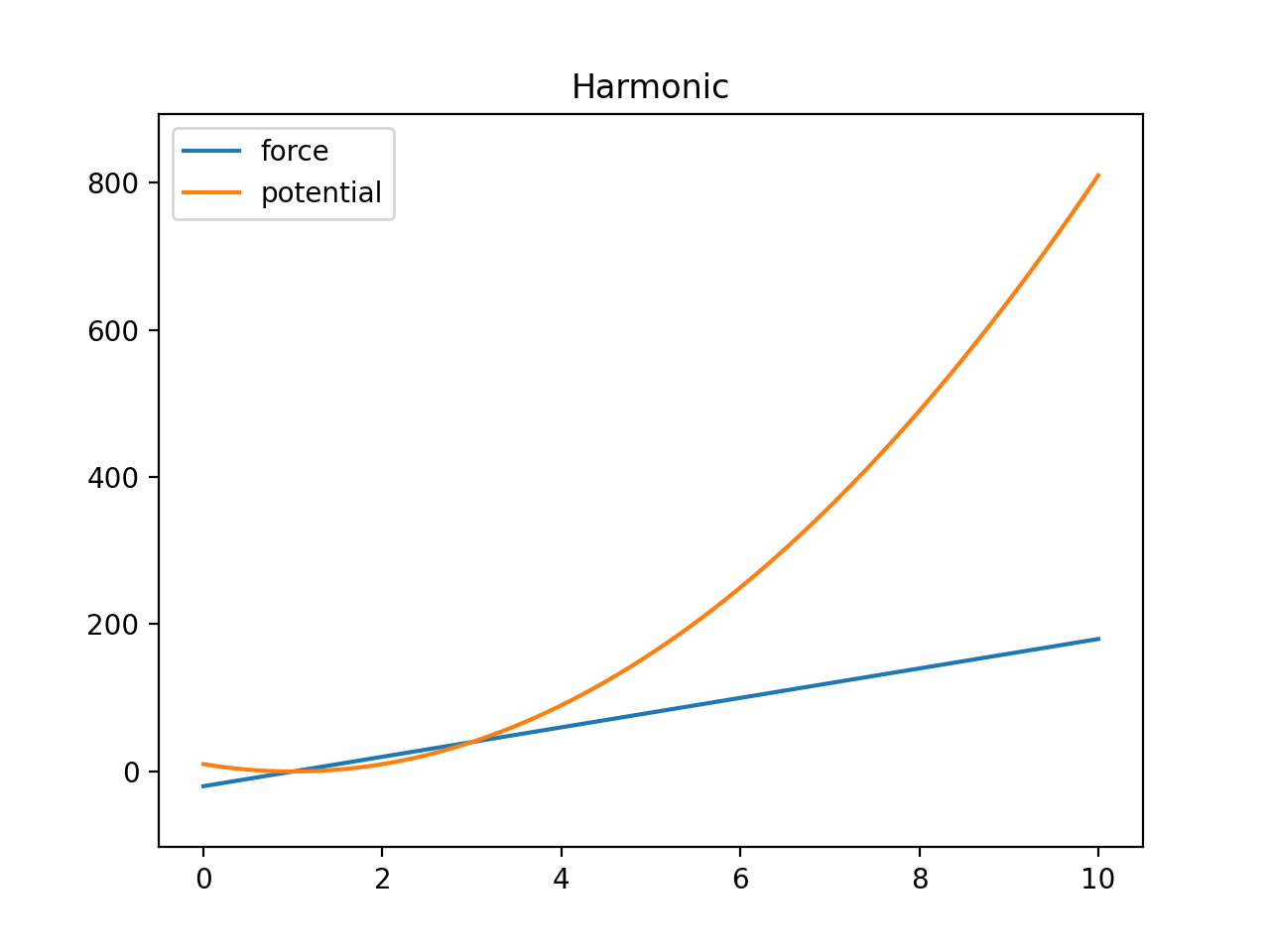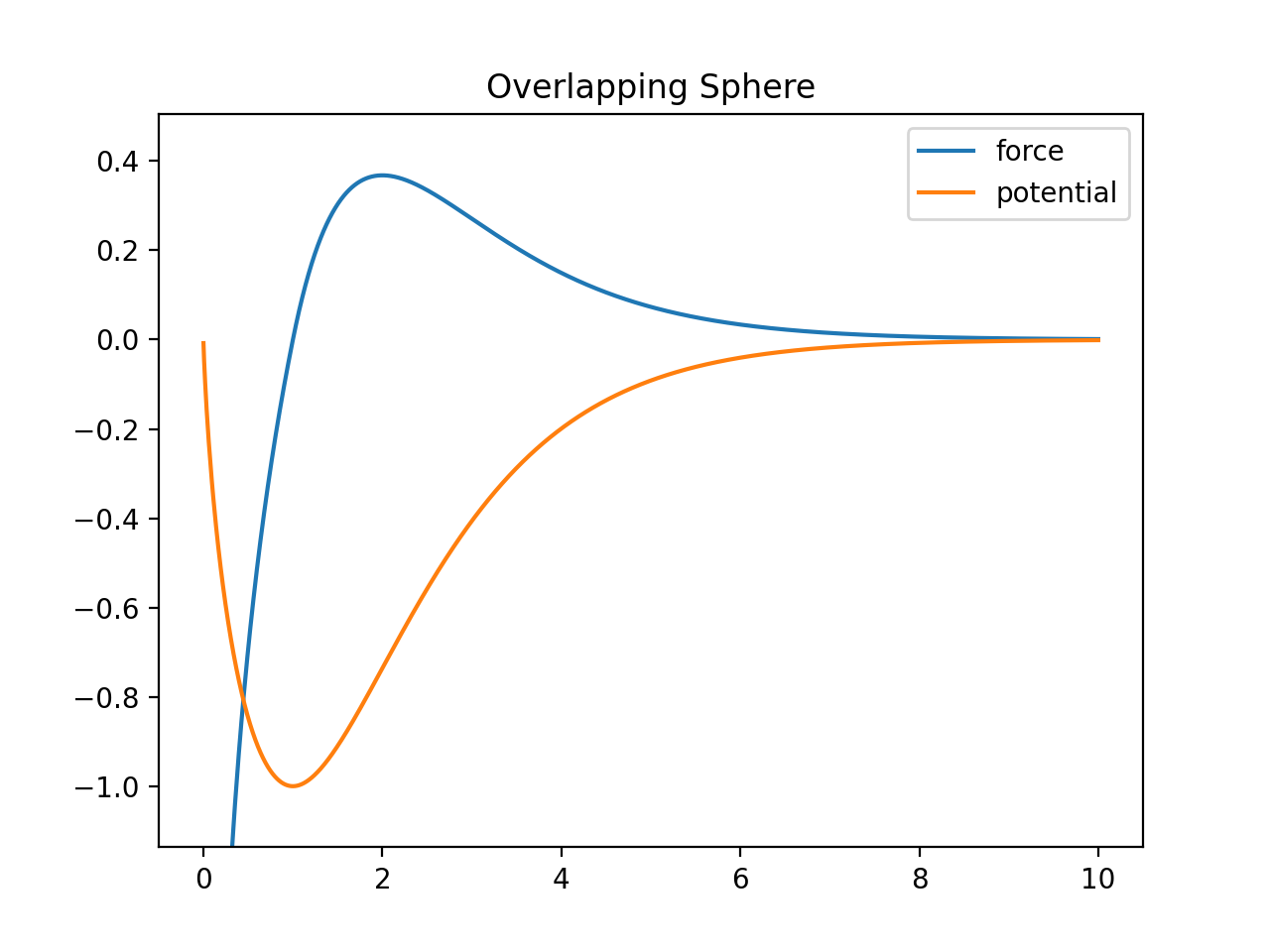Potentials¶
A Potential object is a compiled interpolation of a given function. The Universe applies potentials to particles to calculate the net force on them.
For performance reasons, we found that implementing potentials as interpolations can be much faster than evaluating the function directly.
A potential can be treated just like any python callable object to evaluate it:
>>> pot = m.Potential.lennard_jones_12_6(0.1, 5, 9.5075e-06 , 6.1545e-03, 1.0e-3 )
>>> x = np.linspace(0.1,1,100)
>>> y=[pot(j) for j in x]
>>> plt.plot(x,y, 'r')
-
class
Potential¶ -
static
power([k], [r0], [min], max=[10], [tol=0.001])¶ Parameters: - k – interaction strength, represents the potential energy peak value. Defaults to 1
- r0 – potential rest length, zero of the potential, defaults to 0.
- alpha – Exponent, defaults to 1.
- min – minimal value potential is computed for, defaults to r0 / 2.
- max – cutoff distance, defaults to 3 * r0.
- tol – Tolerance, defaults to 0.01.
some stuff, \(r_0 - r_0 / 2\).
The power potential the general form of many of the potential functions, such as
linear(), etc… power has the form:\[U(r,k) = k (r-r_0)^{\alpha}\]Some examples of power potentials are:
>>> import mechanica as m >>> p = m.Potential.power(k=1, r0=1, alpha=1.1) >>> p.plot(potential=True)
>>> import mechanica as m >>> p = m.Potential.power(k=1,alpha=0.5, r0=1) >>> p.plot(potential=True)
>>> import mechanica as m >>> p = m.Potential.power(k=1,alpha=2.5, r0=1) >>> p.plot(potential=True)
-
static
lennard_jones_12_6(min, max, a, b)¶ Creates a Potential representing a 12-6 Lennard-Jones potential
Parameters: - min – The smallest radius for which the potential will be constructed.
- max – The largest radius for which the potential will be constructed.
- A – The first parameter of the Lennard-Jones potential.
- B – The second parameter of the Lennard-Jones potential.
- tol – The tolerance to which the interpolation should match the exact potential., optional
The Lennard Jones potential has the form:
\[\left( \frac{A}{r^{12}} - \frac{B}{r^6} \right)\]
-
static
lennard_jones_12_6_coulomb(min, max, a, b, tol)¶ - Creates a Potential representing the sum of a
- 12-6 Lennard-Jones potential and a shifted Coulomb potential.
Parameters: - min – The smallest radius for which the potential will be constructed.
- max – The largest radius for which the potential will be constructed.
- A – The first parameter of the Lennard-Jones potential.
- B – The second parameter of the Lennard-Jones potential.
- q – The charge scaling of the potential.
- tol – The tolerance to which the interpolation should match the exact potential. (optional)
The 12-6 Lennard Jones - Coulomb potential has the form:
\[\left( \frac{A}{r^{12}} - \frac{B}{r^6} \right) + q \left(\frac{1}{r} - \frac{1}{max} \right)\]
-
static
ewald(min, max, q, kappa, tol)¶ Creates a potential representing the real-space part of an Ewald potential.
Parameters: - min – The smallest radius for which the potential will be constructed.
- max – The largest radius for which the potential will be constructed.
- q – The charge scaling of the potential.
- kappa – The screening distance of the Ewald potential.
- tol – The tolerance to which the interpolation should match the exact potential.
The Ewald potential has the form:
\[q \frac{\mbox{erfc}( \kappa r)}{r}\]-
static
well(k, n, r0[, min][, max][, tol])¶ Creates a continuous square well potential. Usefull for binding a particle to a region.
Parameters: - k (float) – potential prefactor constant, should be decreased for larger n.
- n (float) – exponent of the potential, larger n makes a sharper potential.
- r0 (float) – The extents of the potential, length units. Represents the maximum extents that a two objects connected with this potential should come appart.
- min (float) – [optional] The smallest radius for which the potential will be constructed, defaults to zero.
- max (float) – [optional] The largest radius for which the potential will be constructed, defaults to r0.
- tol (float) – [optional[ The tolerance to which the interpolation should match the exact potential, defaults to 0.01 * abs(min-max).
\[\frac{k}{\left(r_0 - r\right)^{n}}\]As with all potentials, we can create one, and plot it like so:
>>> p = m.Potential.well(0.01, 2, 1) >>> x=n.arange(0, 1, 0.0001) >>> y = [p(xx) for xx in x] >>> plt.plot(x, y) >>> plt.title(r"Continuous Square Well Potential $\frac{0.01}{(1 - r)^{2}}$ \n", ... fontsize=16, color='black')
-
static
harmonic_angle(k, theta0, [min, ]max[, tol])¶ Creates a harmonic angle potential
Parameters: - k – The energy of the angle.
- theta0 – The minimum energy angle.
- min – The smallest angle for which the potential will be constructed.
- max – The largest angle for which the potential will be constructed.
- tol – The tolerance to which the interpolation should match the exact potential.
returns A newly-allocated potential representing the potential
\[k(\theta-\theta_0)^2\]Note, for computational effeciency, this actually generates a function of r, where r is the cosine of the angle (calculated from the dot product of the two vectors. So, this actually evaluates internally,
\[k(\arccos(r)-\theta_0)^2\]
-
static
harmonic(k, r0[, min][, max][, tol])¶ Creates a harmonic bond potential
Parameters: - k – The energy of the bond.
- r0 – The bond rest length
- min – [optional] The smallest radius for which the potential will be constructed. Defaults to \(r_0 - r_0 / 2\).
- max – [optional] The largest radius for which the potential will be constructed. Defaults to \(r_0 + r_0 /2\).
- tol – [optional] The tolerance to which the interpolation should match the exact potential. Defaults to \(0.01 \abs(max-min)\)
return A newly-allocated potential
\[U(r) = k (r-r_0)^2\]We can plot the harmonic function to get an idea of it’s behavior:
>>> import mechanica as m >>> p = p = m.Potential.harmonic(k=10, r0=1, min=0.001, max=10) >>> p.plot(s=2, potential=True)
-
static
soft_sphere(kappa, epsilon, r0, eta, min, max, tol)¶ Creates a soft sphere interaction potential. The soft sphere is a generalized Lennard Jones type potentail, but you can varry the exponents to create a softer interaction.
Parameters: - kappa –
- epsilon –
- r0 –
- eta –
- min –
- max –
- tol –
-
static
glj(e[, m][, n][, r0][, min][, max][, tol][, shifted])¶ Parameters: - e – effective energy of the potential
- m – order of potential, defaults to 3
- n – order of potential, defaults to 2*m
- r0 – mimumum of the potential, defaults to 1
- min – minimum distance, defaults to 0.05 * r0
- max – max distance, defaults to 5 * r0
- tol – tolerance, defaults to 0.01
- shifted – is this shifted potential, defaults to true
Generalized Lennard-Jones potential.
\[V^{GLJ}_{m,n}(r) = \frac{\epsilon}{n-m} \left[ m \left( \frac{r_0}{r} \right)^n - n \left( \frac{r_0}{r} \right) ^ m \right]\]where \(r_e\) is the effective radius, which is automatically computed as the sum of the interacting particle radii.
-
static
overlapping_sphere(mu=1, [kc=1], [kh=0], [r0=0], [min=0.001], max=[10], [tol=0.001])¶ Parameters: - mu – interaction strength, represents the potential energy peak value.
- kc – decay strength of long range attraction. Larger values make a shorter ranged function.
- kh – Optionally add a harmonic long-range attraction, same as
glj()function. - r0 – Optional harmonic rest length, only used if kh is non-zero.
- min – Minimum value potential is computed for.
- max – Potential cutoff values.
- tol – Tolerance, defaults to 0.001.
The overlapping_sphere function implements the Overlapping Sphere, from [OFPF+17]. This is a soft sphere, from our testing, it appears too soft, probably better suited for 2D models. This potential appears to allow particles to collapse too closely, probably needs more paramater fiddling.
Note
From the equation below, we can see that there is a \(\log\) term as the short range repulsion term. The logarithm is the radial Green’s function for cylindrical (2D) geometry, however the Green’s function for 3D is the \(1/r\) function. This is possibly why Osborne has success in 2D but it’s unclear if this was used in 3D geometries.
\[\begin{split}\mathbf{F}_{ij}= \begin{cases} \mu_{ij} s_{ij}(t) \hat{\mathbf{r}}_{ij} \log \left( 1 + \frac{||\mathbf{r}_{ij}|| - s_{ij}(t)}{s_{ij}(t)} \right) ,& \text{if } ||\mathbf{r}_{ij}|| < s_{ij}(t) \\ \mu_{ij}\left(||\mathbf{r}_{ij}|| - s_{ij}(t)\right) \hat{\mathbf{r}}_{ij} \exp \left( -k_c \frac{||\mathbf{r}_{ij}|| - s_{ij}(t)}{s_{ij}(t)} \right) ,& \text{if } s_{ij}(t) \leq ||\mathbf{r}_{ij}|| \leq r_{max} \\ 0, & \text{otherwise} \\ \end{cases}\end{split}\]Osborne refers to \(\mu_{ij}\) as a “spring constant”, this controls the size of the force, and is the potential energy peak value. \(\hat{\mathbf{r}}_{ij}\) is the unit vector from particle \(i\) center to particle \(j\) center, \(k_C\) is a parameter that defines decay of the attractive force. Larger values of \(k_C\) result in a shaper peaked attraction, and thus a shorter ranged force. \(s_{ij}(t)\) is the is the sum of the radii of the two particles.
We can plot the overlapping sphere function to get an idea of it’s behavior:
>>> import mechanica as m >>> p = m.Potential.overlapping_sphere(mu=10, max=20) >>> p.plot(s=2, force=True, potential=True, ymin=-10, ymax=8)
-
static
linear(k, [min], max=[10], [tol=0.001])¶ Parameters: - k – interaction strength, represents the potential energy peak value.
- min – Minimum value potential is computed for.
- max – Potential cutoff values.
- tol – Tolerance, defaults to 0.001.
The linear potential is the simplest one, it’s simply a potential of the form
\[U(r) = k r\]>>> import mechanica as m >>> p = p = m.Potential.linear(k=5, max=10) >>> p.plot(potential=True)
-
static
Dissapative Particle Dynamics¶
-
Potential.dpd(alpha=1, gamma=1, sigma=1, cutoff=1)¶ Parameters: - alpha – interaction strength of the conservative force
- gamma – interaction strength of dissapative force
- sigma – strength of random force.
The dissapative particle dynamics force is the sum of the conservative, dissapative and random forces:
\[\mathbf{F}_{ij} = \mathbf{F}^C_{ij} + \mathbf{F}^D_{ij} + \mathbf{F}^R_{ij}\]The conservative force is:
\[\mathbf{F}^C_{ij} = \alpha \left(1 - \frac{r_{ij}}{r_c}\right) \mathbf{e}_{ij}\]The dissapative force is:
\[\mathbf{F}^D_{ij} = -\gamma \left(1 - \frac{r_{ij}}{r_c}\right)^{2}(\mathbf{e}_{ij} \cdot \mathbf{v}_{ij}) \mathbf{e}_{ij}\]And the random force is:
\[\mathbf{F}^R_{ij} = \sigma \left(1 - \frac{r_{ij}}{r_c}\right) \xi_{ij}\Delta t^{-1/2}\mathbf{e}_{ij}\]
-
class
DPDPotential¶ A subtype of the Potential class that adds features specific to Dissapative Particle Dynamics.
